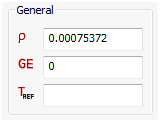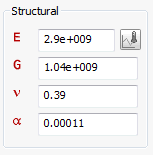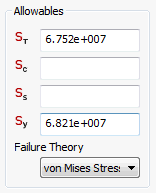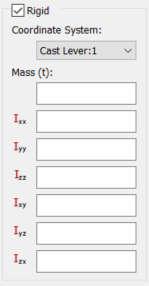After selecting Isotropic from the Type menu, the following material sections are available: General, Structural, Allowables, Rigid, and Thermal.
-
General

-
Structural

- You can input Young’s modulus, shear modulus, Poisson’s ratio, thermal expansion coefficient, mass density, material damping coefficient, and material reference temperature under the General and Structural sections.
- You also have the option to use a temperature dependence curve for Young’s modulus by clicking the
 icon.
icon.
- Either E or G must be specified (i.e. nonblank).
- If any one of E, G, or NU is blank, it will be computed to satisfy the identity E = 2(1 + NU)G; otherwise, values supplied by you will be used.
- If E and NU or G and NU are both blank, they will both be given the value 0.0.
- Implausible data on one or more Isotropic material entries will result in a warning message. Implausible data is defined as any of E < 0.0, or G < 0.0, or NU > 0.5, or NU < 0.0, or |1 – E / [2(1+NU)G]| > 0.01.
- The mass density, RHO, will be used to automatically compute mass for all structural elements.
- To obtain the damping coefficient GE, multiply the critical damping ratio C/C0, by 2.0. If a dominate frequency is not defined for Material Structural Damping (see Dampings section), GE is ignored in transient response analyses.
- TREF and GE are ignored if the Isotropic material is referenced by a composite layup.
- TREF is used only as the reference temperature for the calculation of thermal loads in linear solutions. If an initial temperature load is specified, TREF will be ignored.
-
Allowables

- You can input allowable values for tension, compression, and shear under Isotropic Allowables section.
- Factor of safety calculations are based on two methods: von Mises stress or principal stress. When
Failure Theory is set to
von Mises Stress, the factor of safety is calculated within the application using:

Whereas Nastran solver, in order to calculate STATUS results, is using:

And when Failure Theory is set to Principal Stress, the factor of safety is calculated using:

where ST and SC come from the input fields,
 is the von Mises stress, and
is the von Mises stress, and
 and
and
 are the maximum and minimum principal stresses.
are the maximum and minimum principal stresses.
- Rigid

- Users can define Rigid only for Explicit Dynamics analysis. If Rigid is checked, then all elements assigned with this material created from the property ID will be bound together as a single rigid body for the analysis. All material properties for the elements will simply be ignored except for the density value.
- When an element block is made rigid, it no longer performs any element calculations (for example, no material stresses or strains are computed). Moreover, the elements of the rigid body do not contribute to the Courant stability limit considerations of the analysis. This can vastly increase the performance of some modes and reduce the total computer time for the analysis.
- Autodesk Explicit will compute the center of mass, total mass and the mass properties (location of center of mass and rotary inertia tensor about the center of mass) of the rigid body automatically for you and compute the rigid body motions of the element block due to any forces acting upon it .
-
Thermal

- For thermal analyses, you can input values for conductivity, specific heat, and mass density under the Thermal section. Mass density is repeated since it may be a requirement in thermal analysis as well as in structural analysis.
- Conductivity can be made temperature dependent by clicking the
 icon when a nonlinear heat transfer solution is selected.
icon when a nonlinear heat transfer solution is selected.